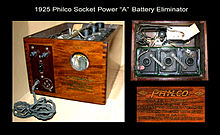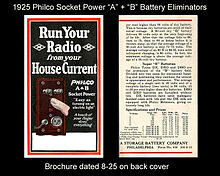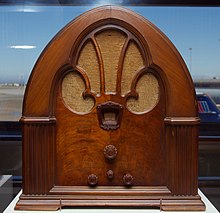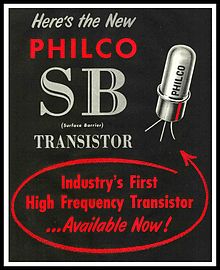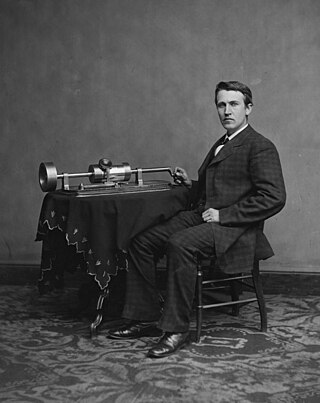
A phonograph, in its later forms also called a gramophone or since the 1940s called a record player, or more recently a turntable, is a device for the mechanical and analogue recording and reproduction of sound. The sound vibration waveforms are recorded as corresponding physical deviations of a spiral groove engraved, etched, incised, or impressed into the surface of a rotating cylinder or disc, called a "record". To recreate the sound, the surface is similarly rotated while a playback stylus traces the groove and is therefore vibrated by it, very faintly reproducing the recorded sound. In early acoustic phonographs, the stylus vibrated a diaphragm which produced sound waves which were coupled to the open air through a flaring horn, or directly to the listener's ears through stethoscope-type earphones.
Magnavox was an American electronics company. It was purchased by North American Philips in 1974, which was absorbed into Dutch electronics company Philips in 1991. The predecessor to Magnavox was founded in 1911 by Edwin Pridham and Peter L. Jensen, co-inventors of the moving-coil loudspeaker at their lab in Napa, California, under United States Patent number 1,105,924 for telephone receivers. Six decades later, Magnavox produced the Odyssey, the world's first home video game console.

The TX-0, for Transistorized Experimental computer zero, but affectionately referred to as tixo, was an early fully transistorized computer and contained a then-huge 64K of 18-bit words of magnetic-core memory. Construction of the TX-0 began in 1955 and ended in 1956. It was used continually through the 1960s at MIT. The TX-0 incorporated around 3,600 Philco high-frequency surface-barrier transistors, the first transistor suitable for high-speed computers. The TX-0 and its direct descendant, the original PDP-1, were platforms for pioneering computer research and the development of what would later be called computer "hacker" culture. For MIT, this was the first computer to provide a System console which allowed for direct interaction, as opposed to previous computers, which required the use of punched card as a primary interface for programmers debugging their programs. Members of MIT's Tech Model Railroad Club, "the very first hackers at MIT", reveled in the interactivity afforded by the console, and were recruited by Marvin Minsky to work on this and other systems used by Minsky's AI group.

Vehicle audio is equipment installed in a car or other vehicle to provide in-car entertainment and information for the vehicle occupants. Until the 1950s it consisted of a simple AM radio. Additions since then have included FM radio (1952), 8-track tape players, cassette players, record players, CD players, DVD players, Blu-ray players, navigation systems, Bluetooth telephone integration, and smartphone controllers like CarPlay and Android Auto. Once controlled from the dashboard with a few buttons, they can now be controlled by steering wheel controls and voice commands.
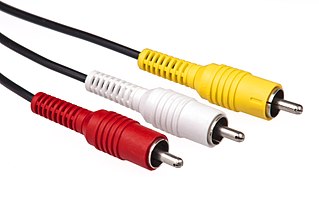
The RCA connector is a type of electrical connector commonly used to carry audio and video signals. The name RCA derives from the company Radio Corporation of America, which introduced the design in the 1930s. The connector’s male plug and female jack are called RCA plug and RCA jack.

A transistor radio is a small portable radio receiver that uses transistor-based circuitry. Following the invention of the transistor in 1947—which revolutionized the field of consumer electronics by introducing small but powerful, convenient hand-held devices—the Regency TR-1 was released in 1954 becoming the first commercial transistor radio. The mass-market success of the smaller and cheaper Sony TR-63, released in 1957, led to the transistor radio becoming the most popular electronic communication device of the 1960s and 1970s. Transistor radios are still commonly used as car radios. Billions of transistor radios are estimated to have been sold worldwide between the 1950s and 2012.
Zenith Electronics, LLC, is an American research and development company that develops ATSC and digital rights management technologies. It is owned by the South Korean company LG Electronics. Zenith was previously an American brand of consumer electronics, a manufacturer of radio and television receivers and other consumer electronics, and was headquartered in Glenview, Illinois. After a series of layoffs, the consolidated headquarters moved to Lincolnshire, Illinois. For many years, their famous slogan was "The quality goes in before the name goes on". LG Electronics acquired a controlling share of Zenith in 1995; Zenith became a wholly owned subsidiary in 1999. Zenith was the inventor of subscription television and the modern remote control, and was the first to develop high-definition television (HDTV) in North America.
Emerson Radio Corporation is one of the United States' largest volume consumer electronics distributors and has a recognized trademark in continuous use since 1912. The company designs, markets, and licenses many product lines worldwide, including products sold, and sometimes licensed, under the brand name G Clef, an homage to Emerson's logo.

The Philco Predicta is a black and white television chassis style, which was made in several cabinet models with 17” or 21” screens by the American company Philco from 1958 to 1960. The Predicta was marketed as the world’s first swivel-screen television. Designed by Catherine Winkler, Severin Jonassen and Richard Whipple, it featured a picture tube (CRT) that separated from the rest of the cabinet.

Bush is a British consumer electronics brand owned by J Sainsbury plc (Sainsbury's), the parent company of the retailer Argos. The former Bush company is one of the most famous manufacturers of early British radios. The company is now defunct, but the Bush brand name survives as a private label brand for budget electronics. Today, all Bush are sold exclusively at Argos and Sainsbury's, with Argos having a wider selection.

An antique radio is a radio receiving set that is collectible because of its age and rarity.
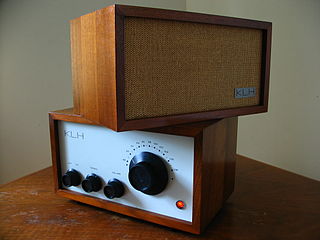
A table radio is a small, self-contained radio receiver used as an entertainment device. Most such receivers are limited to radio functions, though some have compact disc or audio cassette players and clock radio functions built in; some models also include shortwave or satellite radio functionality.

The surface-barrier transistor is a type of transistor developed by Philco in 1953 as an improvement to the alloy-junction transistor and the earlier point-contact transistor. Like the modern Schottky transistor, it offered much higher speed than earlier transistors and used metal–semiconductor junctions, but unlike the schottky transistor, both junctions were metal–semiconductor junctions.
Admiral is an American appliance brand that is currently marketed by Whirlpool Corporation and sold exclusively at The Home Depot.

A transistor computer, now often called a second-generation computer, is a computer which uses discrete transistors instead of vacuum tubes. The first generation of electronic computers used vacuum tubes, which generated large amounts of heat, were bulky and unreliable. A second-generation computer, through the late 1950s and 1960s featured circuit boards filled with individual transistors and magnetic-core memory. These machines remained the mainstream design into the late 1960s, when integrated circuits started appearing and led to the third-generation computer.
A transistor is a semiconductor device with at least three terminals for connection to an electric circuit. In the common case, the third terminal controls the flow of current between the other two terminals. This can be used for amplification, as in the case of a radio receiver, or for rapid switching, as in the case of digital circuits. The transistor replaced the vacuum-tube triode, also called a (thermionic) valve, which was much larger in size and used significantly more power to operate. The first transistor was successfully demonstrated on December 23, 1947, at Bell Laboratories in Murray Hill, New Jersey. Bell Labs was the research arm of American Telephone and Telegraph (AT&T). The three individuals credited with the invention of the transistor were William Shockley, John Bardeen and Walter Brattain. The introduction of the transistor is often considered one of the most important inventions in history.
Koyo Electronics and its subsidiary Koyo Electronics Industry, often collectively referred to as just Koyo, are Japanese electronics companies based in Kodaira, Tokyo that manufactured radios from 1955 until 1973, and now its subsidiary manufactures industrial electronics devices and factory automation control systems.

Majestic Radios was an American radio brand from 1927 to 1955, trademarked as "The Mighty Monarchs of the Air". Noted for their high quality, they were initially manufactured by the Grigsby-Grunow Company of Chicago. After Grigsby-Grunow's demise in 1934 during the Great Depression, Majestic Radios continued to be made through subsequent corporate ownership changes and reorganizations for another twenty-two years. The Majestic Radio & Television Corporation was formed to produce the radios in the 1930s and 1940s. Following Majestic Radio & Television's liquidation in 1949, Majestic-brand radios were made by a division of the Wilcox-Gay Corporation at their Michigan factory in the 1950s.
Philco was one of the pioneers of transistorized computers. After the company developed the surface barrier transistor, which was much faster than previous point-contact types, it was awarded contracts for military and government computers. Commercialized derivatives of some of these designs became successful business and scientific computers. The TRANSAC Model S-1000 was released as a scientific computer. The TRANSAC S-2000 mainframe computer system was first produced in 1958, and a family of compatible machines, with increasing performance, was released over the next several years.
